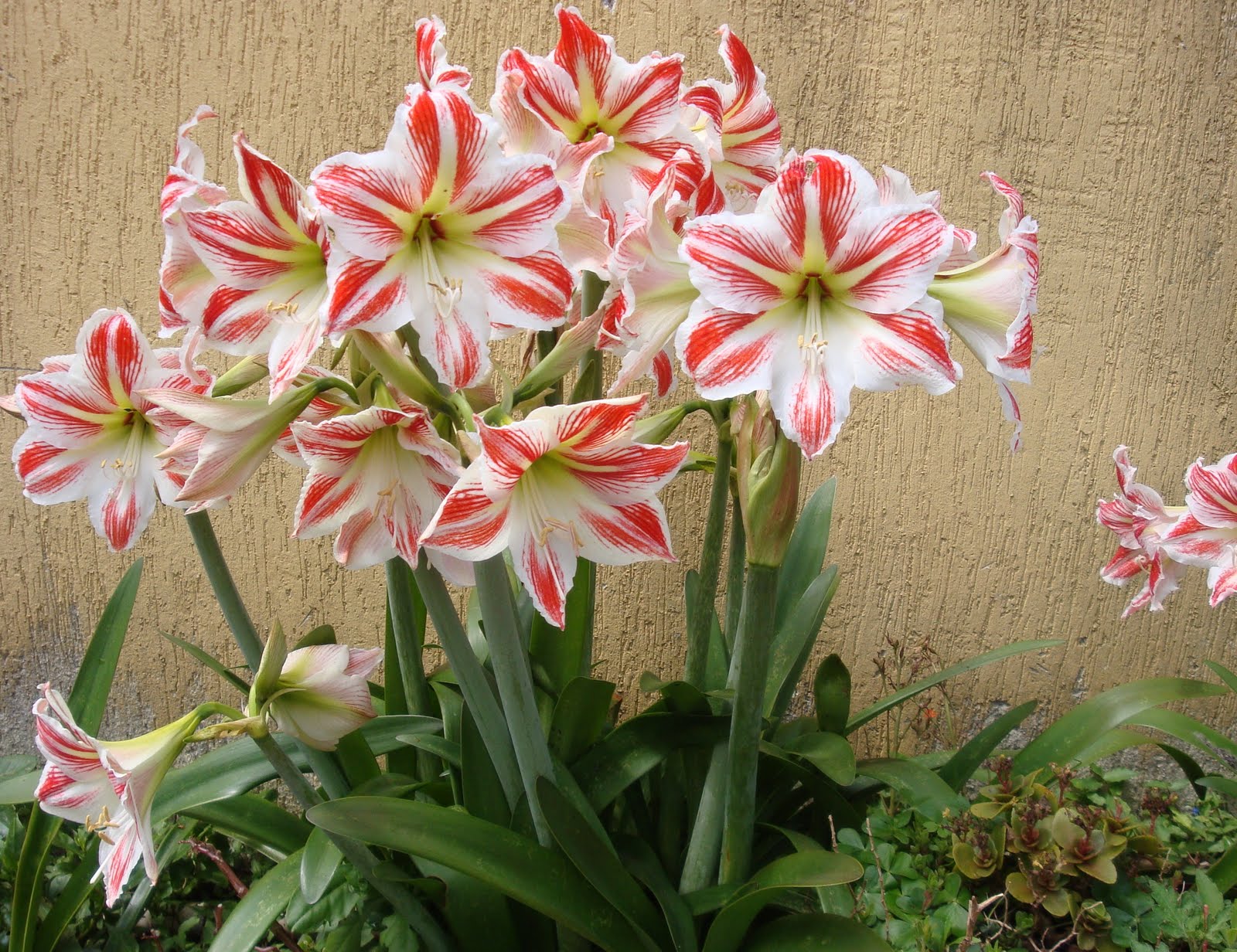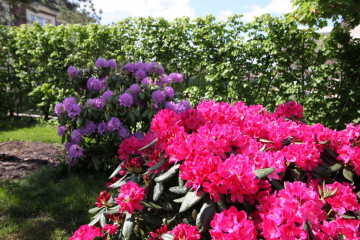How to grow amaryllis garden outdoors
Content:
The genus of monocotyledonous plants Amaryllis belongs to the Amaryllis family. It was allocated into a separate category by the Swedish taxonomist Karl Linnaeus in 1753. According to the description, these are perennial herbaceous bulbous plants, which are characterized by a straight peduncle, bright green, elongated leaves, collected in a lush rosette. The inflorescences are umbellate and include 2-12 flowers. The most famous type of Amaryllis is Belladonna. Planting and growing amaryllis outdoors is not much different from indoor breeding. About what amaryllis is in the garden, the features of planting and caring for the crop are described below.
Choosing a seat for landing
Areas well lit by the sun are suitable for growing a flower. At the same time, they must be protected from strong winds and drafts. These conditions are met by places located at the walls of buildings on the south side.
How to plant in open ground
Many people doubt whether amaryllis can be planted on the street. A perennial is accustomed to a tropical climate, therefore, when grown outdoors, it requires mild conditions. It is not surprising that the plant feels much more comfortable in home pots: in this case, it is much easier to achieve the desired parameters. However, experienced flower growers quite successfully plant amaryllis in the country, in the garden, vegetable garden, flower beds.
Amaryllis in the garden can be grown in two ways: from seeds and bulbs.
Growing from seeds
This method of reproduction is rarely used, since it is complex and does not always end with success.
The seeds are obtained as a result of cross-pollination, which is carried out with a brush (carried over the flowers). Ripening occurs after 2-3 months.
Sowing is carried out as follows:
- The seeds are removed from the capsule.
- A drainage layer about 2 cm thick is laid in the holes.
- A nutritious soil mixture is poured on top (you can use the same as for the bulbs).
- The substrate is tamped.
- Sowing is carried out.
- There should be a distance of up to 1.5 cm between seedlings.
- The soil is sprayed with a spray bottle.
After planting, it is necessary to ensure that the ground does not dry out and does not become waterlogged.
Growing from bulbs
Before planting, you need to check the bulb for density, damage, mold, rot and the presence of developed roots. If, during the inspection, affected areas were found, they must be cut off and the problem areas treated with coal.
It is also necessary to remove dead scales and disinfect the bulb in this order:
- Hold in a solution of potassium permanganate for half an hour.
- Treat with fungicides.
After 24 hours, the planting material will dry out, and then it can be planted in open ground.
Amaryllis on the street must be planted according to the following rules:
- Planting is carried out in late spring - early summer.
- A drain is placed at the bottom of the well.
- The bulbs are completely buried in the substrate (15 cm) and placed at a distance of 25-30 cm from each other.
- Immediately after planting, mulching is done so that the surface of the earth does not dry out.
Watering the beds should be moderate until the height of the shoots reaches 10 cm, and then switch to abundant watering. If you neglect this rule, amaryllis may not bloom: all the energy will be spent on forming a lush rosette.
The soil should be fertile and loose so that air and moisture can pass through well. If the soil does not meet the specified requirements, organic and mineral fertilizers are added to it, and drainage is also carried out. Seedlings appear in late summer - early autumn. Flowering begins in 2-3 years.
Top dressing
Fertilizers are used to stimulate the growth and development of amaryllis. For these purposes, you can use:
- mullein (1 glass per 10 liters of water);
- bird droppings (1 tablespoon is diluted in 10 liters of water).
Top dressing is applied before flowering.
Recommended formulations include the following:
- potassium salt;
- double superphosphate;
- nitrophoska;
- magnesium sulfate;
- ammonium nitrate.
Choose the most affordable and convenient one for you.
Wintering
In late August - early September, the flower is stopped feeding and the frequency of watering is reduced. In late October - early November, watering is excluded. From this moment, leaves begin to fall, and by the end of the season, the stems are completely bare.
It is not recommended to artificially remove the leaves, since in the process of dying off, all the organic substances contained in them pass into the bulb. This creates a nutrient reserve necessary for future flowering. If 2-3 leaves remain for a long time, they can be carefully cut off at the base of the bulb or bent.
During the rest period, amaryllis in the open field should be watered once every 15-20 days. Bulb containers are stored in a cool dry (5-12 degrees) place (storeroom, greenhouse, garage, winter garden). Lighting of the flower at rest is not required. In this form, the bulbs are left for 8-9 weeks.
Watering amaryllis
Moderate watering is carried out immediately after planting. Some growers have been convinced from personal experience that at first it is useful not to water the plant at all. When the peduncles grow 10 cm, moisture is made abundant. Moisture is provided as the soil dries. It is very important not to overflow the bulb during the procedure.
Growing problems
Amaryllis is very sensitive to changes in growing conditions. At the same time, garden amaryllis are perennial plants that are not as often exposed to diseases and pests as many other crops.
It often happens that the plant does not bloom. This can be caused by the following factors:
- Bad soil or lack of fertilizer.
- Wrong location of the flower, in connection with which the plant experiences a lack of lighting or is exposed to a draft.
- If the plant is not transplanted for the winter, then over time, a large number of bulbs will form at the root of the amaryllis. This leads to the lack of flowering. To prevent this from happening, it is recommended to separate the bulbs from the roots once every 3 years.
- Planting the bulb too deep, as a result of which the culture will not be able to form a well-developed peduncle.
Among the diseases and pests from which amaryllis most often suffers are the following:
- Root rot.
- Bulb mold.
- Decay of leaves and peduncles along with flowers.
- Spider mite.
- Red burn (staganosporosis), which affects the scales of the bulb.
- Viral mosaic.
- Thrips.
- Mealybug.
- Amaryllis bug.
- Shield.
- Soft false shield.
- Aphid.
- Leopard.
- Narcissus fly.
Signs of a red burn are:
- Crimson spots on foliage and shoots.
- Stopping the growth of the green parts of the flower, loss of elasticity.
Root rot symptoms are brown spots on the leaves. You can cure the culture by ridding it of the affected areas and treating the flower with foundation.
Often, amaryllis leaves are attacked by thrips, which suck juice from the plant. The results of their vital activity are indicated by white specks on the surface of the leaves. In the fight against pests, spraying the flower with actellik or karbofos will help.
If green spots appear on the leaves, it means that the plant is sick with a viral mosaic.
Disease prevention
High-quality flower care serves to prevent diseases and pests. Careful treatment of the bulbs with hot water before rooting will also help to avoid problems. It is necessary to water the plants at the root - this will exclude the ingress of drops on the leaves and shoots.
Why amaryllis foliage turns yellow
There may be 2 reasons:
- Defeat by aphids or thrips. The solution is to process the flower with actelik.
- Excess moisture. The solution is to adjust the watering regime.
Why amaryllis has pale leaves
The reason is the culture's long exposure to the bright sun. The foliage burns out and loses its color saturation. The dull color of the leaves, coupled with their wilting, can be associated with waterlogging of the soil or lack of drainage. It is also not recommended to spray the leaves.
Garden amaryllis has high decorative qualities. It can be grown both at home and in the open field. In order for the culture to please with its flowering as long as possible, it is necessary to properly care for it and adhere to the rules for planting in open ground.





















